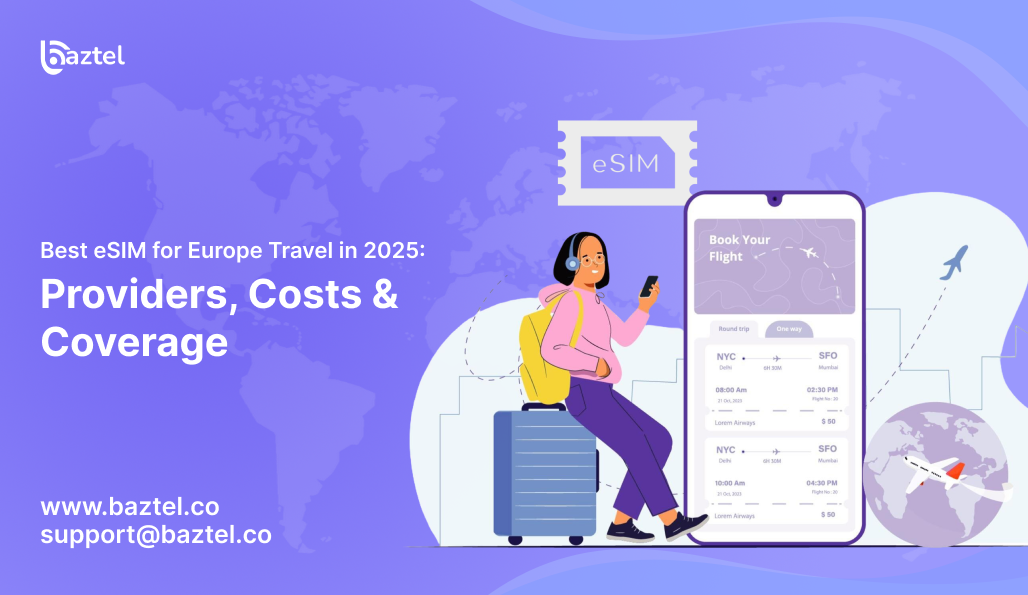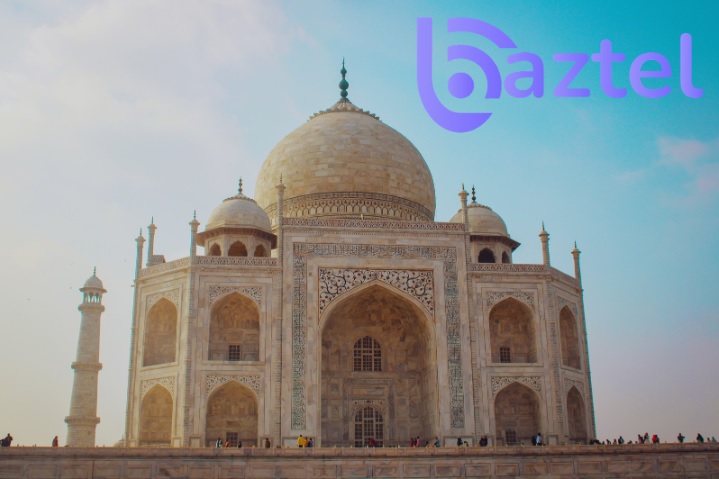Europe is one of the most digitally digested areas of the planet, with 4G coverage of almost the entire country and a fast 5G network expanding rapidly in almost all major cities. For passengers in 2025, it is not just a function; it is part of navigating, transport booking, searching for restaurants, sharing memories and managing work while living abroad. Choosing the eSIM for a trip to Europe means balancing three important things: coverage, cost and ease of use.
Unlike traditional plastic SIMs, an eSIM is completely digital, so you can activate a data plan before activating a data plan through a fast QR code scan. This means a strong eSIM Europe plan can cover 30–40 countries under one profile, so you can cross borders seamlessly by train or car without buying separate cards. Competitive eSIM data Europe options also bring flexibility: pay-as-you-go bundles for light users, generous 20–50 GB packages for regular travellers, and “unlimited” plans with fair-use caps for business or streaming. The right eSIM transforms connectivity into a background task, leaving you free to focus on the cafés, castles, and culture Europe is famous for.
Why eSIMs Are Perfect for Europe
An eSIM, or “embedded SIM”, is really an essential piece that is already made in the smartphone, tablet or even a smartwatch. Instead of inserting a physical plastic card, download a digital SIM profile from a supplier and install it by scanning the QR code or by entering an activation code. Within minutes, the device is connected to the local network, for example, because you bought a SIM at the airport kiosk.
Europe is particularly well suited to eSIMs for several reasons:
- Dense, border-rich geography: Travelling from Paris to Brussels or Vienna to Prague can be done in hours. A single eSIM covering multiple nations spares you repeated SIM swaps.
- The EU’s regulatory environment: EU rules encourage proper prices, transparent roaming and interoperability, which simplifies how carriers treat passengers across the border.
- Market competition: Many suppliers now pack 30-40 countries in a European scheme, eliminating the requirement for separate contracts in each destination.
Key benefits go beyond convenience. Activation is instant you can set up your plan before leaving home. There’s no plastic waste, making it eco-friendly. Your home is active for SIM calls and texts, while eSIM handles data. Most of the plans support hotspot-teclothing and flexible toppings, which means you can share a connection with laptops or tablets and add all the data as needed without going to the store.
How to Pick the Right Plan
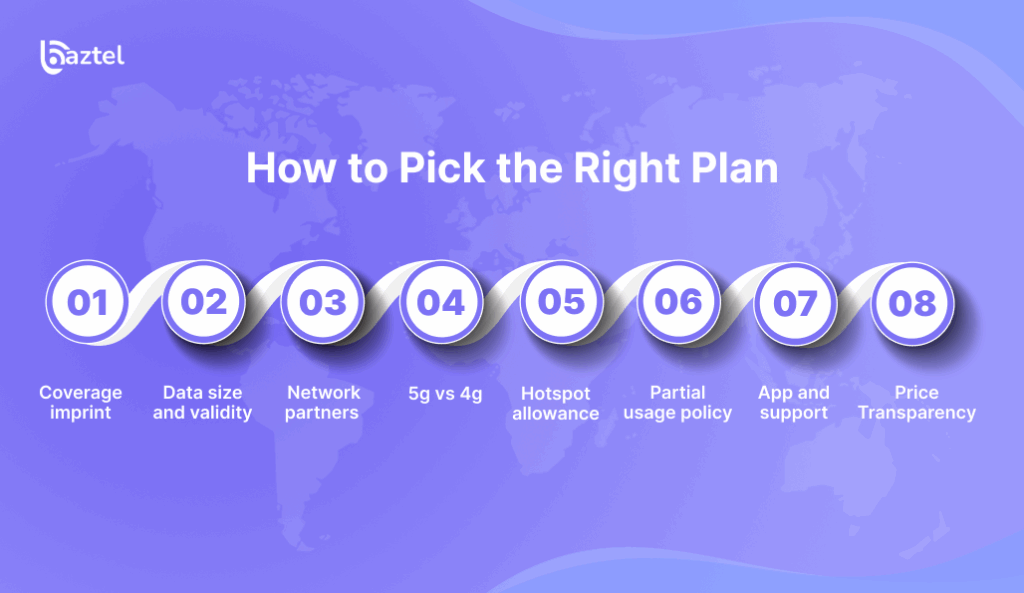
An eSIM is a built-in digital SIM that lets you activate mobile service instantly by downloading a profile no physical card or shop visit needed. For Europe’s dense network of neighbouring countries, eSIMs are ideal: one plan can cover 30–40 nations with seamless roaming. Travellers gain fast setup, clear pricing, and freedom to keep their home SIM active for calls. Features like hotspot support, 4G/5G access, and easy top-ups make eSIM for Europe travel a cost-effective, eco-friendly connectivity solution.
1. Coverage imprint
Make sure the plan clearly shows each country. You normally do not want “Europe”. Some ESIMs leave microstates or non-European Union association countries (e.g., Serbia, Switzerland). Cross-check the supplier map with your travel programme to avoid dead areas.
2. Data size and validity
Match the package with both how long you want to stay and what you want to do online. Light users (maps, messages) can be found at 3-5 GB for a week, while streamers or remote workers may require 15-30 GB for multi-week trips. The validity period for a plan (e.g., 7, 30 or 90 days) must cover the entire journey.
3. Network partners
Top-level carriers (Telecom, Orange, Vodafone) offer strong coverage, especially outside cities. The individuals who collaborate with these TIs-1 networks usually provide low-baptised calls and fast data rates.
4. 5g vs 4g
Europe’s 5G rollout is expanded, but 4G LTE is widely available and is completely sufficient for maps, e-post messages, video calls and even HD streaming. Treat 5G as a bonus, not an appointment.
5. Hotspot allowance
If you are planning to tether a portable or tablet, the use of hotspots is not blocked or throttled. Some “unlimited” eSIM users disable the speed of tethering or hot-spotting silently after a small allowance.
6. Partial usage policy
Many unlimited or high-diet schemes reduce the speed after a limit (e.g., 30 GB). Read the nice print to avoid unexpected trouble, especially if you trust high-speed data for work.
7. App and support
A clear, well-designed app simplifies activation, tapping and troubleshooting. Check if the supplier provides 24/7 chat or e-post help. Smooth UX case when navigating in a foreign language at midnight.
8. Price Transparency
Good providers show cost per GB, total package cost, and any roaming or overage fees upfront. Avoid vague “unlimited” claims unless the fair-use limits are explicitly stated.
Baztel Europe eSIM Plans (Real‑World Example)
Baztel has carved out a niche by combining transparent pricing with unusually generous validity, perfect for travellers who want flexibility instead of juggling short-lived bundles.
- Plan: 20 GB
- Validity: 90 days
- Price: $29
This package spans most major EU countries plus the UK, Switzerland, Norway, and several non-EU neighbours. By partnering with dual Tier-1 networks in each country, Baztel ensures stable coverage even where one carrier’s signal dips.
Key advantages:
- Hotspot support for laptops and tablets
- Instant purchase online, QR code emailed within minutes
- Quick install no need to swap physical SIMs or visit a kiosk
- Works seamlessly for multi-week vacations, study-abroad terms, or frequent EU trips across a single season
The per-GB cost is well below most short-term tourist eSIMs, and the 90-day window means you can activate before departure, use a few gigs on an early visit, and still have data for later stops. For travellers seeking a flexible, pan-European option, Baztel’s plan ranks among the most traveller-friendly eSIM Europe plans of 2025.
Other Top eSIM Europe Options
By mapping your travel profile duration, countries visited, and data intensity to these categories, you can quickly zero in on the eSIM for Europe travel. Baztel fits snugly in the long-validity bracket, while services like Airalo shine for quick tours, and unlimited plans cater to digital nomads who can’t afford throttling.
1. Regional Europe Bundles
These packages pool dozens of countries under one profile, ideal for travelers hopping between capitals.
- Typical Data: 3–20 GB
- Validity: 7–30 days
- Use Case: Short-to-medium trips covering multiple nations (e.g., Paris–Amsterdam–Berlin).
- Examples: Airalo Eurolink, Nomad Europe, Holafly Regional Europe, Ubigi Multi-Country Europe.
- Why Choose: One purchase covers your whole itinerary, with predictable pricing and instant activation.
2. “Unlimited” Plans with Fair-Use Caps
Marketed as unlimited, but most throttle after a set limit. Perfect for travellers who rely heavily on mobile data.
- Typical Data: 60–120 GB at full speed, then slowed (1–3 Mbps).
- Validity: 7–30 days (some extendable).
- Use Case: Remote work, HD streaming, uploading large files, frequent video calls.
- Examples: Holafly Unlimited Europe, Saily, Maya Mobile.
- Why Choose: Peace of mind—no meter watching, robust for business travellers.
3. Long-Validity / Pay-as-You-Go Bundles
Great for flexibility across semesters, gap years, or frequent repeat visits.
- Typical Data: 1–10 GB starter packs, often refillable
- Validity: 30–180 days
- Use Case: Backpackers, digital nomads, or anyone with scattered trips over months.
- Examples: Baztel 20 GB / 90 days, Nomad Lite, Flexiroam, and Truphone.
- Why Choose: Activate once and keep rolling; ideal for travellers who don’t want the pressure of daily data clocks.
4. Country-Specific Local eSIMs
These mimic buying a domestic SIM without leaving your Airbnb.
- Typical Data: 10–100 GB, sometimes with local voice minutes/SMS
- Validity: 14–90 days (varies by operator)
- Use Case: Students on language courses, interns, long homestays anyone staying put in one country for weeks.
- Examples: Orange France Holiday SIM, Vodafone Germany eSIM, TIM Italy eSIM.
- Why Choose: Larger data pools at lower cost per GB, better speeds, sometimes includes domestic calls.
Comparison Snapshot
| Plan/Type | Data & Validity | Countries | 5G | Hotspot | Price (approx) | Ideal Traveller |
| Baztel Europe | 20 GB / 90 d | 30+ | 4G/5G | Yes | $29 | Multi‑week, budget‑savvy |
| Regional Bundle | 10 GB / 30 d | 30–40 | Mixed | Yes | $25–35 | 1–3 week trips |
| Unlimited (FUP) | 80 GB / 30 d | 30–40 | 5G | Often | $40–60 | Heavy work/stream |
| Long Validity | 5 GB / 180 d | 25–35 | Mixed | Yes | $15–25 | Nomads, repeat |
| Local Country | 50 GB / 60 d | 1 | 5G | Yes | $15–30 | Long stay |
Coverage Across Europe
- Western & Northern Europe – Consistently Strong
Countries like Germany, France, the UK, the Netherlands, and Scandinavia have some of the world’s densest 4G grids and rapidly expanding 5G in nearly all urban areas. Rail lines and major highways maintain robust signals, letting you stream or join calls even while commuting between cities. Only remote fjords or mountain valleys occasionally show dips, and most plans seamlessly fall back to LTE.
- Southern & Eastern Europe – Good Urban, Variable Rural
Spain, Italy, Greece, Croatia, Hungary and Poland maintain 4G in cities, tourist hubs and transport corridors. Coverage in rural coasts, mountain towns or low-travel inland areas can be seen at 3G or slower, especially on secondary carriers. Partners with Tier-1 networks reduce these holes but cannot completely eliminate them.
- Microstates & Islands – Check the Fine Print
Places such as Andorra, Monaco, San Marino, Liechtenstein and popular islands (Greek islands, Canary Islands, Madeira) do not always have bundles in all “Europe-wide” schemes. Check the coverage list on the eSIM supplier’s website, especially if your travel programme includes Ferry Marg or Alpine Drive, where the cell tower is rare.
5G Reality Check
Europe’s most important capitals are mature 5G rollouts in London, Paris, Berlin, Madrid, Amsterdam, Rome, Zurich and others, who provide passengers quick downloads and less delay in urban centres. Professional districts, airports and large railway stations are usually blanketed in the next-gen coverage. However, once you have left the dense urban core, trains, highways or old buildings often indicate an automatic decline for 4G LTE. Navigation for practical features, RIDE sleeve, messages or photo sharing: 4G speed is more than enough; even an app with an average delay is sufficient to perform. Passengers can rely on 4G in the form of standard stylishness and enjoy 5G outbreaks in a high-traffic zone.
Price Benchmarks (2025)
For Europe, an ESIM passenger immediately connects to boundaries without the exchange of plastic cards. Choosing the right eSIM Europe scheme depends on how much data you want to use, travel length, and whether you need hotspot support or 5G. Light users can survive on some gigabytes, while frequent photographers or streamers require large bundles or “unlimited” levels of use. Offers like Baztel stand out by connecting generous validity with clear prices, making it easier to keep home SIM active by enjoying spontaneous, environmentally friendly eSIM data.
| User Profile | Data & Validity | Typical Price Range | Notes / Best Fit |
| Light Users | 3–5 GB / 30 days | $8–20 | Basic navigation, email, chat apps, occasional social uploads |
| Typical Travellers | 10–20 GB / 15–30 days | $15–35 | Photos, maps, moderate video, daily browsing across cities |
| Heavy / Remote Work | “Unlimited” (FUP 80–120 GB) | $25–60 | Video calls, large file sync, streaming, cloud work |
| Baztel Europe Plan | 20 GB / 90 days | $29 | Long validity, dual-network, excellent for multi-week or repeat trips |
Installation Steps
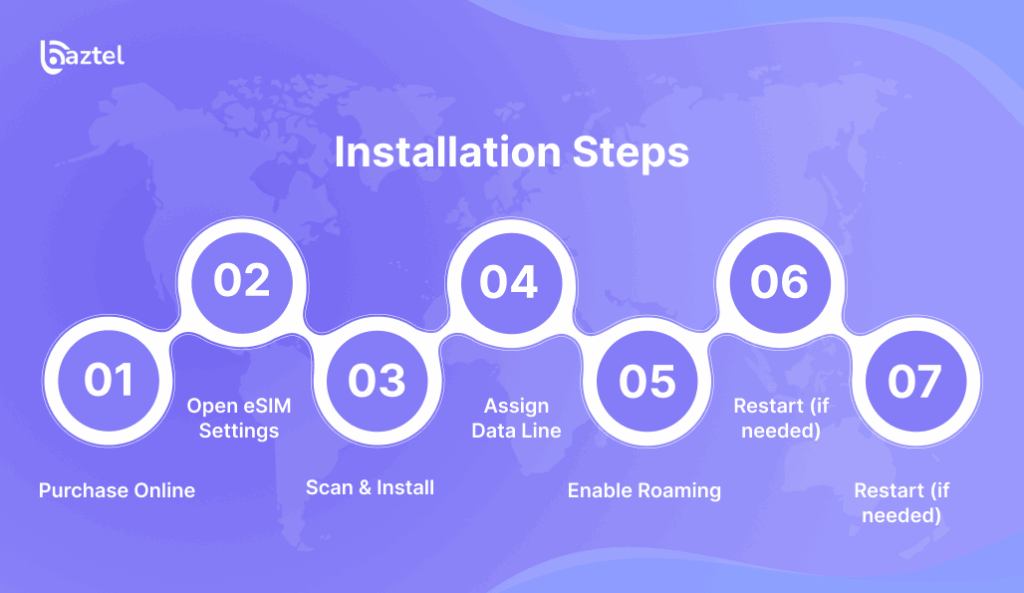
- Purchase Online
Choose your provider and pay for the plan. Most send a QR code plus an activation code immediately by email or inside their app. - Open eSIM Settings
On iPhone: Settings → Mobile Data / Cellular → Add eSIM
On Android (varies): Settings → Connections → SIM Manager → Add Mobile Plan. - Scan & Install
Use your phone’s camera to scan the QR. Your device downloads the digital SIM profile and prompts you to name it—label something clear like “Europe eSIM.” - Assign Data Line
Select the new profile as your primary data line, leaving your home SIM active for calls or SMS if you wish. - Enable Roaming
Turn on Data Roaming for the eSIM. This lets it connect across multiple European networks automatically. - Restart (if needed)
Most phones connect instantly, but a quick reboot can help if the network doesn’t appear right away. - Confirm Connection
Check your signal bars and APN settings (usually auto-configured). Run a quick speed test or open a webpage to ensure you’re online.
With these simple steps, you’re connected before you even step out of the airport, ready to navigate, message, and share photos on a seamless esim Europe plan.
Data Planning Tips
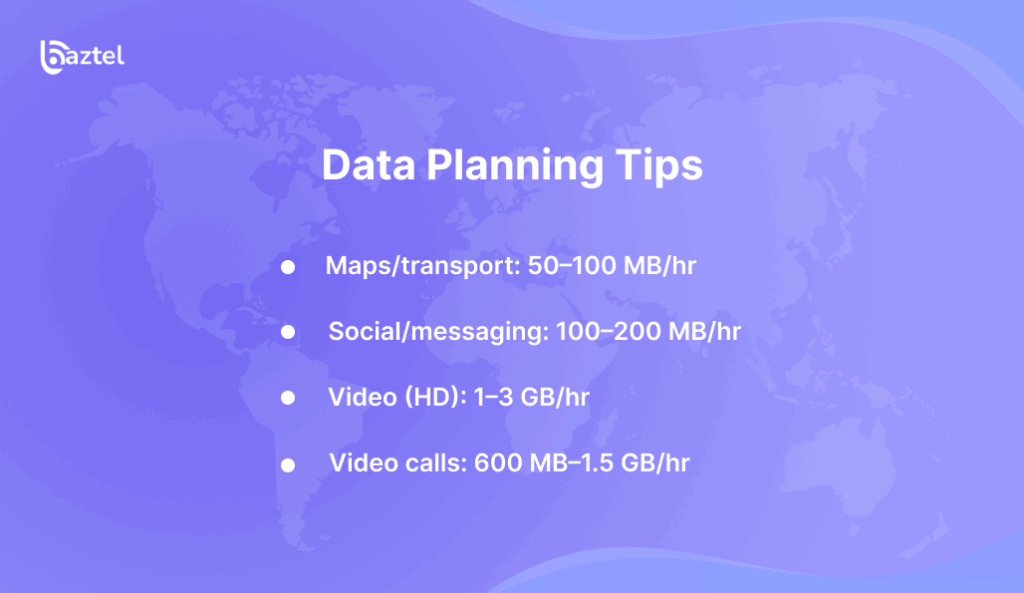
Average usage by activity:
- Maps/transport: 50–100 MB/hr
- Social/messaging: 100–200 MB/hr
- Video (HD): 1–3 GB/hr
- Video calls: 600 MB–1.5 GB/hr
A 2‑week multi‑city holiday with daily maps and socials typically uses 8–12 GB. Add 5–10 GB if you hotspot a laptop.
FAQs
Do I get a phone number?
Most eSIM Europe plans are data-only, meaning no local number for calls or SMS. Travellers typically use WhatsApp, Signal, FaceTime, or other VoIP apps for voice and messaging. A few carriers sell add-on voice packs, but for casual trips, app-based calling is simpler.
Is hotspot/tethering allowed?
The majority of reputable regional providers Baztel, Airalo, Nomad, Ubigi permit personal hotspot use, letting you share data with a laptop or tablet. Always confirm in the plan’s fine print, as some “unlimited” offers restrict tethering after a usage threshold.
Can I store multiple eSIMs?
Yes. Modern iPhones and many Androids allow several eSIM profiles to be stored. Only one data line can be active at a time (dual-SIM standby lets you keep a voice line from your home SIM simultaneously).
What happens if I exceed my data?
Data-only bundles stop at the cap. Most providers allow top-ups directly in the app. “Unlimited” plans rarely cut you off but throttle speeds to ~1–3 Mbps once the fair-use limit (often 60–120 GB) is hit.
Will it work on trains and across borders?
Yes. Seamless roaming is a core eSIM feature. Expect brief signal drops in long tunnels or at remote border crossings, but the device automatically reconnects to the next available partner network.
Do I really need 5G?
It’s a nice bonus for big downloads or cloud sync, especially in major capitals. For maps, messaging, and streaming, 4G LTE delivers plenty of speed with lower battery drain.
Conclusion
For 2025, a long‑validity regional plan like Baztel’s 20 GB / 90‑day Europe eSIM is among the eSIM for Europe travel—covering 30+ nations, simple QR setup, and budget‑friendly. Combine that with 5G‑ready city networks and fair policies, and your trip runs smoother without hunting for SIM shops. If you’ll linger in one country, local eSIMs still win per‑GB value, but for most tourists and nomads, a regional plan means freedom to roam.
Blog Author
Peter
Peter started BazTel.co to make mobile internet easier for travellers. He noticed how tough it was to find good network options while visiting new countries. That’s when he built BazTel — a place where anyone can buy eSIMs online without confusion or long steps. He believes tech should be simple and useful, not complicated. When he’s free, he likes to travel, test BazTel himself, and keep improving it based on real user problems.

 Botswana
Botswana Zambia
Zambia Congo
Congo Colombia
Colombia China mainland
China mainland Chile
Chile Chad
Chad Central African Republic
Central African Republic Canada
Canada Cameroon
Cameroon Cambodia
Cambodia Burkina Faso
Burkina Faso Bulgaria
Bulgaria Brunei Darussalam
Brunei Darussalam Brazil
Brazil Aland Islands
Aland Islands Bosnia and Herzegovina
Bosnia and Herzegovina Bolivia
Bolivia Belgium
Belgium Belarus
Belarus Bangladesh
Bangladesh Bahrain
Bahrain Azerbaijan
Azerbaijan Austria
Austria Australia
Australia Armenia
Armenia Argentina
Argentina Algeria
Algeria